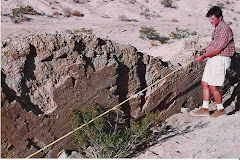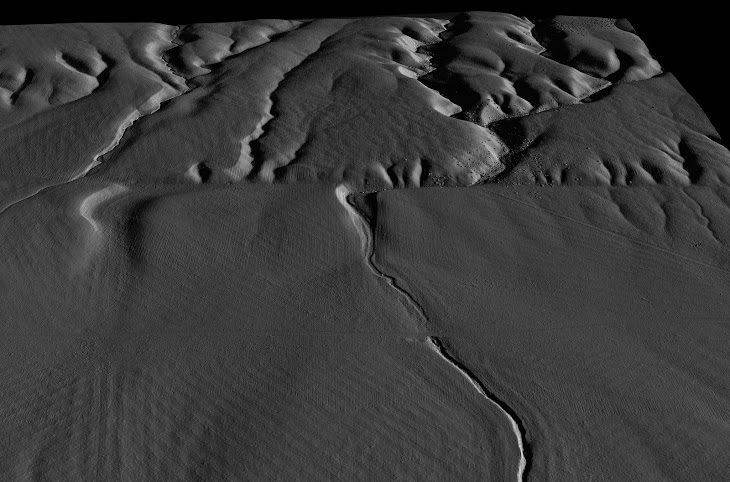Friday, October 21, 2016
Re-activate or not?
Should I start posting here again? I look forward to your comments on the relative merits of blogging vs. tweeting. Blogs seem to be ignored, whereas tweets are too terse. What do you think?
Monday, July 7, 2014
A couple of our papers have been published recently, and below are the links to these in-depth scientific articles about the 1920 Haiyuan, China and the 2010 El Mayor - Cucapah, Mexico earthquakes. This is how we scientists typically get the information out about our research findings.
To help spread the word, I tweeted links, but I realize that unfortunately such links would or could probably truly reach and be read by only a very few people. These papers are like precious droplets entering the vast sea of newly published literature. I hope you'll follow these links and find the content interesting. If you encounter problems, please let me know.
In the first case, the article was published in an open-access journal, so you may simply download it freely:
http://link.springer.com/article/10.1007/s11434-014-0199-4
The second case is not as simple. Here is a link to the journal web page, where you can read the abstract for free:
http://m.geosphere.gsapubs.org/content/early/2014/06/24/GES00933.1
To obtain a copy of the full PDF of the article, however, one would need to pay. Or else, for free, you can first become a registered user of ResearchGate and then sign in and download it here:
http://www.researchgate.net/profile/Orlando_Teran/publication/263467078_Assembly_of_a_large_earthquake_from_a_complex_fault_system_Surface_rupture_kinematics_of_the_4_April_2010_El_MayorCucapah_%28Mexico%29_Mw_7.2_earthquake/file/60b7d53af306855baf.pdf?origin=publication_detail
Many people, including me, believe that it should not have to be expensive or complicated for the general public to access such information. Major initiatives are occurring across all scientific endeavors to open up the access to the literature and data that have, in most cases, been paid for by the taxpayers. Here is the more general issue in the form of an OSTP policy memo and accompanying petition that has been signed by over 65,000 people:
http://www.whitehouse.gov/sites/default/files/microsites/ostp/ostp_public_access_memo_2013.pdf
https://petitions.whitehouse.gov/response/increasing-public-access-results-scientific-research
People should get what they've paid for, and yet the journals need to make ends meet. Various new models can sustain on-line publication by recovering costs, while also maintaining a rigorous peer review process. Freely available data sets are distributed through servers that must be occasionally upgraded and kept connected to the internet, and the information is kept well organized by people who of course require salaries. Journals are scanning old articles and making them much more readily accessible on-line at an impressive rate.
Scientists work hard to publish research in journals. Most people do not subscribe to these journals, and most articles are written in jargon, so even if someone does locate an article by title and find the abstract, several challenges remain. First, they must either pay to download the article or find a roundabout way to download it through their library or alternative access. Then, they must read and comprehend the article even if it is not in their own area of expertise. Although best for scientist-to-scientist exchange of information, this path presents too much information (TMI) for most people who might potentially be interested in some new results. In the past, one main alternative to this path was to give interviews to science reporters who would then either edit video into sound bites or interpret and write about the science in plain language. Often, this cuts the science down to too little information (TLI) and can often frustrate the scientists who worked hard to generate the new information. The journalists' editors might find their article too technical unless it has been ratcheted up with a sensational headline and some science-distorting hyperbole as a 'hook.'
Free and open access to publications and data sets is clearly the way to go for most things (but, interestingly, not all things). Often, however, this 'open' model leaves a gap between the expert scientific specialists in a field and the many people who would potentially like to understand their findings. The web introduces great new alternative forms of communication, if only we can make full use of these options. To communicate these days should one tweet (TLI?), blog or just write good old fashioned papers (TMI?)? The answer seems to be, "all of the above." It seems to me the blog is a good in-between solution, but it also seems that blogs receive relatively little readership and attention. Please prove me wrong by responding with your comments to this posting.
To help spread the word, I tweeted links, but I realize that unfortunately such links would or could probably truly reach and be read by only a very few people. These papers are like precious droplets entering the vast sea of newly published literature. I hope you'll follow these links and find the content interesting. If you encounter problems, please let me know.
In the first case, the article was published in an open-access journal, so you may simply download it freely:
http://link.springer.com/article/10.1007/s11434-014-0199-4
The second case is not as simple. Here is a link to the journal web page, where you can read the abstract for free:
http://m.geosphere.gsapubs.org/content/early/2014/06/24/GES00933.1
To obtain a copy of the full PDF of the article, however, one would need to pay. Or else, for free, you can first become a registered user of ResearchGate and then sign in and download it here:
http://www.researchgate.net/profile/Orlando_Teran/publication/263467078_Assembly_of_a_large_earthquake_from_a_complex_fault_system_Surface_rupture_kinematics_of_the_4_April_2010_El_MayorCucapah_%28Mexico%29_Mw_7.2_earthquake/file/60b7d53af306855baf.pdf?origin=publication_detail
Many people, including me, believe that it should not have to be expensive or complicated for the general public to access such information. Major initiatives are occurring across all scientific endeavors to open up the access to the literature and data that have, in most cases, been paid for by the taxpayers. Here is the more general issue in the form of an OSTP policy memo and accompanying petition that has been signed by over 65,000 people:
http://www.whitehouse.gov/sites/default/files/microsites/ostp/ostp_public_access_memo_2013.pdf
https://petitions.whitehouse.gov/response/increasing-public-access-results-scientific-research
People should get what they've paid for, and yet the journals need to make ends meet. Various new models can sustain on-line publication by recovering costs, while also maintaining a rigorous peer review process. Freely available data sets are distributed through servers that must be occasionally upgraded and kept connected to the internet, and the information is kept well organized by people who of course require salaries. Journals are scanning old articles and making them much more readily accessible on-line at an impressive rate.
Scientists work hard to publish research in journals. Most people do not subscribe to these journals, and most articles are written in jargon, so even if someone does locate an article by title and find the abstract, several challenges remain. First, they must either pay to download the article or find a roundabout way to download it through their library or alternative access. Then, they must read and comprehend the article even if it is not in their own area of expertise. Although best for scientist-to-scientist exchange of information, this path presents too much information (TMI) for most people who might potentially be interested in some new results. In the past, one main alternative to this path was to give interviews to science reporters who would then either edit video into sound bites or interpret and write about the science in plain language. Often, this cuts the science down to too little information (TLI) and can often frustrate the scientists who worked hard to generate the new information. The journalists' editors might find their article too technical unless it has been ratcheted up with a sensational headline and some science-distorting hyperbole as a 'hook.'
Free and open access to publications and data sets is clearly the way to go for most things (but, interestingly, not all things). Often, however, this 'open' model leaves a gap between the expert scientific specialists in a field and the many people who would potentially like to understand their findings. The web introduces great new alternative forms of communication, if only we can make full use of these options. To communicate these days should one tweet (TLI?), blog or just write good old fashioned papers (TMI?)? The answer seems to be, "all of the above." It seems to me the blog is a good in-between solution, but it also seems that blogs receive relatively little readership and attention. Please prove me wrong by responding with your comments to this posting.
Wednesday, May 28, 2014
Article: "Precise to a fault: How GPS revolutionized seismic research"
Here's a nice article that was published recently in EARTH magazine, entitled "Precise to a fault: How GPS revolutionized seismic research," written by John Stenmark. He describes ways in which my colleagues and I have used GPS to study fault motions, beginning back in 1989 with the Loma Prieta earthquake. It is amazing to think back on how GPS technology has changed, and how many ideas and how much hard work by so many people it has taken to make it better along the way. Sometimes too much credit is given to one person for what really took a group or even a community. During the GPS L1C signal design work, I had the pleasure and honor to work with several of the prototype originators of GPS itself. They are commemorated in the GPS Hall-of-Fame at the Los Angeles Air Force Base. This EARTH article, which describes my application of GPS to earthquake research, also makes me reflect upon where we'd be without those true innovators of GPS. Their remarkable navigation & timing system prototype development was a truly great accomplishment.
"If I have seen further, it is by standing on the shoulders of giants." - Isaac Newton, 1676
[ http://www.earthmagazine.org/article/precise-fault-how-gps-revolutionized-seismic-research ]
"If I have seen further, it is by standing on the shoulders of giants." - Isaac Newton, 1676
[ http://www.earthmagazine.org/article/precise-fault-how-gps-revolutionized-seismic-research ]
Monday, November 11, 2013
The San Andreas fault at Cajon Pass
The San Andreas fault at Cajon Pass; this view is from one of our USGS-Caltech SoSAFz sites that I upgraded to improve low-latency GPS performance for use in the prototype earthquake early warning system. The red arrows point to the trace of the fault where it passes up Lone Pine Canyon towards Wrightwood, California in the distance. Los Angeles is behind (south, or to the left of) the San Gabriel Mountains in this photo. Click the small image below to see the full-res annotated photo.
What happens when...?
Sometimes a question is asked that you have never heard before; it challenges you to think differently about how to explain something to the public or to a student in clear terms, without jargon. I love it when that happens; a recent result is this interesting 'Critical Opalescence' Scientific American blog article by George Musser -- @gmusser -- http://blogs.scientificamerican.com/critical-opalescence/2013/11/11/what-happens-to-google-maps-when-tectonic-plates-move/
Friday, January 25, 2013
An article has been published on our new balloon LiDAR system - you can get the open access PDF file without a journal subscription (click for link). [ http://www.mdpi.com/2072-4292/5/2/521/ ]
Subscribe to:
Posts (Atom)





